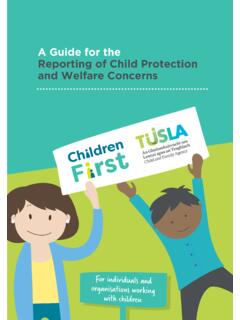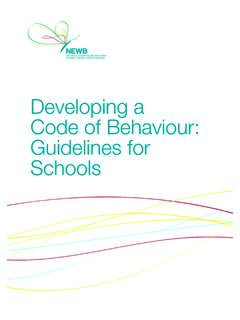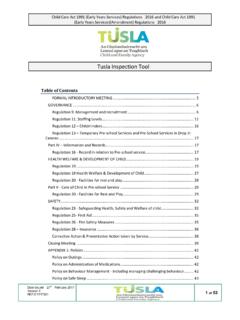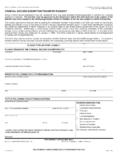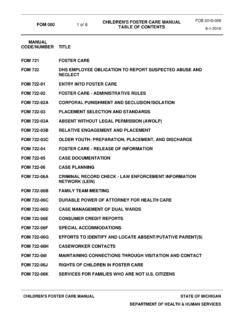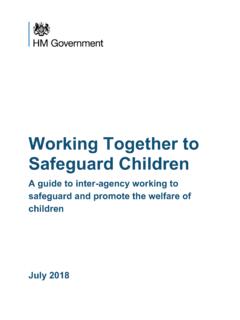Transcription of National Guidance for the Protection and Welfare of …
1 National Guidance for the Protection and Welfare of Children National Guidance for the Protection and Welfare of Children DEPARTMENT OF CHILDREN AND YOUTH AFFAIRS. 2017. This edition of Children First: National Guidance for the Protection and Welfare of Children replaces previous editions and should be the only one in use. It is intended for use by the general public, mandated persons and other professionals whose work brings them into contact with children and also by staff and volunteers of organisations providing services to children. Social workers and staff of Tusla Child and Family agency , should note that the Child Protection and Welfare Practice Handbook is the reference point for all practice detail.
2 Copyright Minister for Children and Youth Affairs, 2017. Department of Children and Youth Affairs 43 49 Mespil Road Dublin 4. D04 YP52. Ireland Tel: +353 (0)1 647 3000. Email: Web: Published by Government Publications, Dublin ISBN 978-1-4064-2954-1. The Department of Children and Youth Affairs should be acknowledged in all references to this publication. For rights of translation or reproduction, please contact the Department of Children and Youth Affairs. i CONTENTS. Minister's Foreword iv Chapter 1: Introduction and Use of this Guidance 1. Overview of child Welfare and Protection 2. Children First Act 2015 3.
3 Status of this Guidance 3. How to use this Guidance 4. Chapter 2: Child Abuse What is It? How do I recognise it? How do I report it? 5. Aim of chapter 6. Reasonable grounds for concern 6. Types of child abuse and how they may be recognised 7. Neglect 7. Emotional abuse 8. Physical abuse 9. Sexual abuse 10. Circumstances which may make children more vulnerable to harm 11. Bullying 12. Reporting a concern about a child 13. Who to contact 13. What information to include 13. Can a report be made anonymously? 14. What happens after a report is received by Tusla? 15. Concerns about an adult who may pose a risk to children 15.
4 Relevant legislation 16. Child Care Act 1991 16. Protections for Persons Reporting Child Abuse Act 1998 16. Criminal Justice Act 2006 16. Criminal Justice (Withholding of Information on Offences against Children and Vulnerable Persons) Act 2012 17. National Vetting Bureau (Children and Vulnerable Persons) Acts 2012 2016 17. Children First Act 2015 17. Criminal Law (Sexual Offences) Act 2017 17. Chapter 3: Mandated Persons 18. Aim of chapter 19. Who are mandated persons? 19. What are the legal obligations of a mandated person? 19. ii Reporting mandated concerns 20. Criteria for reporting: definitions and thresholds 20.
5 Neglect 21. Emotional abuse/ill-treatment 21. Physical abuse 21. Sexual abuse 21. Disclosures of abuse from a child 22. Mandated persons who work with adults 22. Dealing with a retrospective allegation 23. Exemptions from requirements to report 23. Underage consensual sexual activity 23. Concerns developed outside of professional duties 24. Making a mandated report 24. Joint reporting 25. Informing the family that a report is being made 25. Informing the employer or designated liaison person 25. Consequences of non-reporting 26. Mandated assisting 27. Sharing information 27. Protection from civil liability 28. Advice, information and training for mandated persons 28.
6 Chapter 4: Responsibilities of Organisations Dealing with Children and Young People 29. Aim of chapter 30. Statutory obligations of relevant services 30. What are relevant services under the Act? 31. Risk assessment 32. Understanding what risks to assess 32. Carrying out a risk assessment 33. Child Safeguarding Statement 34. What the Child Safeguarding Statement should contain 34. Making the Child Safeguarding Statement available 34. Register of non-compliance 35. Safeguarding best practice procedures for all organisations 35. Appointing a designated liaison person 35. Role of designated liaison person 36. Designated liaison persons and mandated persons 36.
7 Reporting concerns about a child 36. Vetting 37. Advice, information and training for staff and volunteers of organisations 38. iii Chapter 5: Dealing with Concerns about a Child Tusla and An Garda S och na 39. Aim of chapter 40. Tusla - Child and Family agency 40. An Garda S och na 41. Joint working between Tusla and An Garda S och na 42. Joint specialist interviews 42. What happens after a concern is reported? 43. Receipt of concerns 43. Initial checks 44. Social work assessment of a concern 44. Concerns which require family support services 45. Concerns which require child Protection intervention 45. Child Protection Notification System 46.
8 Child Protection Plan 46. Sharing information with a third party 47. Rights of parents 47. Rights of children 48. Feedback to persons reporting concerns 48. Complaints procedure 48. Chapter 6: Oversight of Child Welfare and Protection 49. Aim of chapter 50. Government Departments 50. Department of Children and Youth Affairs 50. Children First Interdepartmental Implementation Group 50. Oversight groups 51. Sectoral implementation plans 51. Advice, information and training 52. Other relevant bodies 52. Health Information and Quality Authority 52. Ombudsman for Children's Office 53. National Review Panel 53. Appendices 54.
9 Appendix 1: Schedule of Relevant Services under the Children First Act 2015 55. Appendix 2: Schedule of Mandated Persons under the Children First Act 2015 57. Appendix 3: Sexual Offences as set out in the Children First Act 2015 [as amended by the Criminal Law (Sexual Offences) Act 2017] 59. Appendix 4: Pathway of a Child Welfare or Protection Concern Reported to Tusla 60. iv MINISTER'S FOREWORD. It is everyone's responsibility to protect children and young people and to do our best to keep them safe. Despite our best efforts, we cannot, unfortunately, prevent all abuse from taking place. What we can do is work together to help make our children's lives safer.
10 It is important that families, communities and professionals can recognise when a child or young person is being harmed and that they know what action to take in response. This revised version of Children First: National Guidance for the Protection and Welfare of Children describes the four main types of abuse and sets out the steps which should be taken to ensure that the child or young person is protected from harm. It has been updated to include new information about the Children First Act 2015 and it includes specific information for the professionals and organisations that now have legal obligations to keep children safe.
